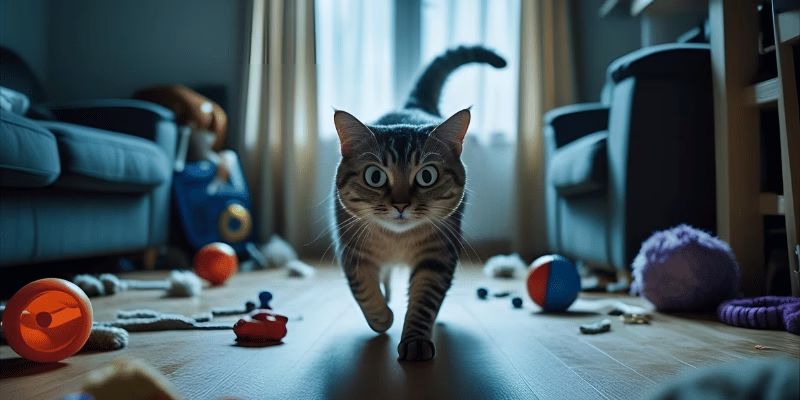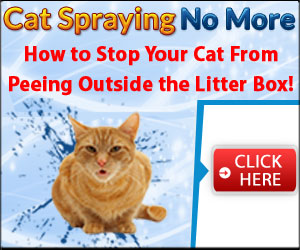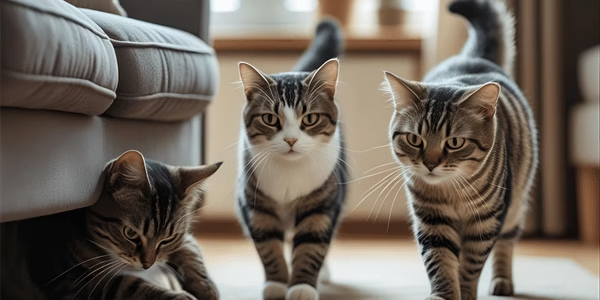🚨 URGENT: Your cat’s “behavioral problems” might actually be a medical emergency in disguise.
New research reveals what’s really behind your cat’s confusing behaviors – and the proven solutions that actually work
If your cat is doing ANY of these things, you need to act NOW:
✅ Urinating outside the litter box
✅ Hiding more than usual
✅ Excessive vocalization or crying
✅ Aggressive behavior toward other cats
✅ Destructive scratching furniture
✅ Acting hungry but walking away from food
You’re not alone, and this isn’t your fault. New veterinary research reveals that 41% of indoor cats suffer from a hidden stress epidemic that’s destroying their mental health – and most owners have no idea it’s happening.
The Shocking Numbers Behind This Crisis
Recent studies reveal the devastating scope of this problem:
-
25.4% of US households own cats – over 46.5 million homes potentially affected
-
At least 10% of all cats develop elimination problems directly linked to stress
-
Pet owners spend over $847 million annually on stress-related behavioral issues
-
1 in 5 cats live with other cats they don’t get along with, creating constant tension
What’s Really Happening to Your Cat Right Now
Dr. Federica Pirrone’s groundbreaking 2025 research found that stress and inflammation actually lead to cognitive decline in cats, creating a vicious cycle of behavioral problems that only get worse over time.
Your cat isn’t being “bad” or trying to spite you. They’re suffering from a stress-related condition that most cat owners never recognize until it’s too late.
The inappropriate urination, hiding, aggression, and other troubling signs you’re seeing are desperate attempts at communication from an animal that literally cannot tell you they’re in distress.
The Most Common Warning Signs You’re Missing
Elimination Problems: When cats pee outside the litter box, most owners assume it’s defiance. The reality? This is almost always stress-related or medical. If inappropriate urination is already disrupting your home, Cat Spraying No More (now with limited 30% OFF) offers an immediate, proven solution that has helped over 50,000 cat owners stop this behavior for good.
Silent Suffering: Unlike dogs, cats are masters at hiding distress. Your cat could be experiencing severe stress for months before you notice obvious symptoms.
Territory Wars: In multi-cat homes, cats engage in “silent conflicts” – territorial negotiations that happen without obvious fighting, but create chronic stress for all cats involved.
Why Traditional Solutions Fail Every Time
You’ve probably tried the standard advice:
✅ More litter boxes (1 per cat plus 1)
✅ Different litter types
✅ Moving boxes to “better” locations
✅ Expensive vet visits that find “nothing wrong”
These solutions fail because they address symptoms, not the root cause. It’s like taking aspirin for a broken leg – you might feel better temporarily, but the underlying problem remains.
🔥 CRITICAL DISCOVERY: The real cause of your cat’s problems lies in understanding how indoor life creates an invisible stress epidemic that’s literally rewiring their brains…
The Hidden Stress Epidemic That’s Destroying Your Cat’s Mental Health
What I’m about to tell you will change everything you thought you knew about cat behavior.
The same research that revealed 41% of cats are kept indoors also uncovered something terrifying: these indoor cats are suffering from chronic stress at levels that would be considered psychological torture in humans.
Why Indoor Life Is Literally Driving Cats Insane
Cats evolved as solitary, territorial hunters with complex environmental needs. When we confine them indoors – even with the best intentions – we’re inadvertently creating a pressure cooker of stress.
The Perfect Storm of Indoor Stress
Territory Compression: In the wild, a cat’s territory spans several acres. In your home, multiple cats are forced to share the same small space, creating constant tension. Research shows that 51% of veterinarians believe cat welfare could be improved by addressing multi-cat household problems.
Sensory Deprivation: Indoor cats are deprived of complex sensory experiences they desperately need: varied textures, natural scents, weather changes, and visual stimulation. This leads to what researchers call “learned helplessness.”
Chronic Vigilance: Unable to patrol territory or escape threats, indoor cats exist in constant hypervigilance. Their stress hormones remain elevated 24/7, leading to the devastating symptoms you’re witnessing.
The Brain Chemistry Breakdown
Here’s the terrifying part: Chronic stress actually changes your cat’s brain structure. Elevated cortisol levels flood their system, causing:
Physical Changes:
-
Bladder wall inflammation (making urination painful)
-
Immune system suppression
-
Digestive disruption
-
Increased sensitivity to environmental triggers
Behavioral Changes:
-
Association of litter box with stress/pain
-
Territorial marking to create security
-
Avoidance of conflict areas
-
Withdrawal and hiding behaviors
The Multi-Cat Household Crisis
1 in 5 cats live with cats they don’t get along with – but here’s the shocking part: most owners never realize it because cats engage in “silent conflict.”
What Silent Conflict Looks Like:
-
Cats avoiding certain areas of the house
-
One cat always eating first while others wait
-
Time-sharing favorite spots (never being together)
-
Subtle blocking behaviors (sitting in doorways)
-
Different cats using separate litter boxes exclusively
For households where territorial stress has already led to spraying or elimination problems, Cat Spraying No More provides step-by-step protocols specifically designed to address territorial marking while reestablishing proper elimination behaviors.
The Medical Connection That Changes Everything
Feline Idiopathic Cystitis (FIC) – bladder inflammation without bacterial infection – is directly linked to stress. Cats with FIC experience:
-
Frequent, urgent urination
-
Pain during elimination
-
Association of litter box with discomfort
-
Seeking “safer” elimination locations
The Scent Communication Crisis
What most owners don’t understand: inappropriate urination often begins as communication, not defiance.
Cats use urine to:
-
Mark territory boundaries during stress
-
Signal anxiety to other cats
-
Create familiar scent trails for security
-
Communicate time-sharing information
The problem? Once this communication pattern starts, it becomes self-reinforcing. The scent markers increase anxiety in other cats, creating a cycle that’s nearly impossible to break without proper intervention.
🚨 BREAKTHROUGH: Understanding your cat’s stress signals is just the first step. The next page reveals the immediate environmental changes that can transform your cat’s behavior in as little as 48 hours…
The Emergency Solutions That Work in 48 Hours
Based on the latest veterinary research, here are the immediate changes that can start transforming your cat’s behavior within 48 hours.
Most cat owners are shocked to discover how quickly their “problem cat” becomes peaceful and content once their environment properly supports their psychological needs.
Immediate Stress-Reduction Strategies
Environmental Modifications That Work Instantly
Vertical Territory Creation:
-
Add cat trees, shelves, or perches to create 3D territory
-
Cats feel more secure when they can observe from height
-
Reduces competition for ground-level space in multi-cat homes
Resource Multiplication:
-
Provide separate food, water, and litter stations for each cat
-
Place resources in different rooms to prevent guarding behaviors
-
Ensure each cat has their own “safe zone” for retreat
Sensory Enrichment:
-
Add scratching posts with different textures (sisal, carpet, cardboard)
-
Rotate toys weekly to maintain novelty and interest
-
Install window perches for outdoor viewing (mental stimulation)
The Territory Mapping Solution
For Multi-Cat Households:
Create distinct territorial zones by:
-
Placing litter boxes in separate areas (not side by side)
-
Establishing feeding stations in different rooms
-
Providing multiple water sources throughout the house
-
Installing baby gates to create visual barriers while maintaining access
For Single Cats:
Address external territorial triggers by:
-
Blocking views of outdoor cats that create stress
-
Creating hiding spots near windows for security
-
Establishing consistent daily routines for predictability
Breaking the Elimination Problem Cycle
Understanding the Stress-Elimination Connection
When cats feel territorially insecure, they use elimination to:
-
Mark boundaries and claim space
-
Communicate stress to other household cats
-
Create familiar scent trails for comfort
-
Signal changes in household dynamics
Critical insight: Once negative associations with litter boxes develop, environmental changes alone often aren’t enough. Cat Spraying No More offers the specialized behavioral retraining techniques needed to rebuild positive litter box associations and stop inappropriate elimination permanently.
The Clean Slate Protocol
Step 1: Complete Scent Elimination
-
Use enzyme cleaners specifically designed for cat urine
-
Clean ALL previous accident sites thoroughly
-
Allow 24-48 hours for complete odor neutralization
Step 2: Litter Box Optimization
-
Replace all litter boxes with new ones (remove negative associations)
-
Use unscented, clumping litter exclusively
-
Maintain 2-3 inches depth maximum
-
Clean daily and completely replace weekly
Step 3: Location Security
-
Place boxes in quiet, low-traffic areas
-
Ensure easy escape routes (no dead ends)
-
Avoid areas near loud appliances or sudden noises
-
Provide adequate lighting for security
Stress-Reduction Techniques That Work
Daily Routine Establishment
Feeding Schedule:
-
Consistent meal times create security and predictability
-
Separate feeding areas prevent competition stress
-
Use puzzle feeders to engage natural hunting behaviors
Play Therapy:
-
10-15 minutes of interactive play before meals
-
Focus on prey-like movements (feather wands, laser pointers)
-
End sessions with successful “kills” (letting cat catch toy)
-
Provides physical exercise and mental stimulation
Environmental Comfort Optimization
Safe Spaces:
-
Cardboard boxes or covered beds for hiding
-
Quiet areas away from household activity
-
Consistent temperature and minimal drafts
-
Soft surfaces for comfort and security
Pheromone Support:
-
Feliway diffusers in main living areas
-
Calming sprays on bedding and furniture
-
Plug-in diffusers near litter boxes and feeding areas
When Immediate Intervention Is Critical
Call your veterinarian immediately if your cat shows:
-
Complete loss of appetite for more than 24 hours
-
Straining to urinate or defecate
-
Blood in urine or stool
-
Excessive hiding with lethargy
-
Aggressive behavior that poses safety risks
For persistent elimination problems that don’t respond to environmental changes within 7-10 days, Cat Spraying No More provides the comprehensive behavioral modification system that addresses both stress triggers and elimination retraining simultaneously.
🎯 TRANSFORMATION POINT: These environmental changes will help 70% of cats show improvement within a week. But for complete behavior transformation and long-term success, you need the comprehensive action plan revealed on the final page…
Your Complete Cat Transformation System
After implementing the emergency solutions from page 3, you’re ready for the comprehensive approach that creates lasting change and prevents future behavioral problems.
This is where most cat owners either succeed completely or continue struggling with recurring issues. The difference lies in understanding that sustainable behavior change requires both environmental management AND behavioral retraining.
The 30-Day Complete Transformation Protocol
Week 1: Foundation Building
Days 1-3: Assessment and Immediate Safety
-
Document all current behavioral issues with photos/videos
-
Implement emergency stress-reduction changes from page 3
-
Establish new daily routines for feeding and play
-
Begin pheromone therapy in main living areas
Days 4-7: Environmental Optimization
-
Add vertical territory options (cat trees, shelves)
-
Create distinct resource zones for each cat
-
Eliminate territorial stress triggers (blocking outdoor cat views)
-
Install additional hiding spots and comfort areas
Week 2: Behavioral Retraining
Positive Association Building:
-
Feed cats near previously problematic areas (at safe distance)
-
Use high-value treats in areas where accidents occurred
-
Engage in positive play sessions throughout the house
-
Reward appropriate elimination with immediate treats
Stress Trigger Desensitization:
-
Gradually expose cats to low-level versions of stress triggers
-
Pair exposure with positive experiences (treats, play, attention)
-
Increase exposure slowly as cats show comfort
-
Never force interactions or proximity between conflicted cats
Week 3: System Integration
Multi-Cat Household Management:
-
Establish separate daily routines for each cat if needed
-
Create positive associations between cats using feeding protocols
-
Implement parallel activities (simultaneous but separate play sessions)
-
Monitor for improvements in silent conflict behaviors
Single Cat Optimization:
-
Increase environmental enrichment and mental stimulation
-
Address any remaining territorial insecurities
-
Fine-tune daily routines based on observed preferences
-
Maintain consistency in all environmental management
Week 4: Long-Term Success Planning
Behavior Maintenance:
-
Establish permanent environmental management systems
-
Create crisis prevention protocols for household changes
-
Develop early warning sign recognition skills
-
Plan for ongoing environmental enrichment rotation
The Elimination Problem Solution
Here’s the hard truth: While environmental management helps 70% of cats improve, cats with established elimination problems often need specialized behavioral retraining that goes beyond environmental changes.
Why Most Solutions Fail:
-
They address environment but not learned behaviors
-
Cats have already developed negative associations with litter boxes
-
Stress triggers remain unidentified and unaddressed
-
Owners lack the specific retraining protocols needed for success
Cat Spraying No More provides the missing piece: a complete behavioral modification system that has helped over 50,000 cat owners permanently stop inappropriate elimination. The system includes:
✅ Stress trigger identification protocols to find hidden causes of elimination problems
✅ Step-by-step retraining techniques that rebuild positive litter box associations
✅ Multi-cat household management strategies for territorial marking issues
✅ Crisis prevention plans to stop problems from recurring
✅ 24/7 support access for troubleshooting difficult cases
Success Metrics to Track
Week 1 Improvements:
-
Reduced hiding and increased confidence
-
Return to normal eating and drinking patterns
-
Decreased vocalization and stress signals
-
Initial reduction in inappropriate elimination incidents
Week 2-4 Transformations:
-
Consistent appropriate elimination behavior
-
Improved social interactions between cats
-
Increased play and exploration behaviors
-
Stable daily routines and predictable responses
Long-Term Success Indicators:
-
Complete elimination of inappropriate urination/spraying
-
Confident, relaxed body language and behavior
-
Positive social interactions with family members
-
Resilience to minor household changes
When Professional Help Is Essential
Contact a veterinary behaviorist immediately for:
-
Aggressive behaviors that pose safety risks
-
Complete social withdrawal lasting more than a week
-
Self-destructive behaviors (excessive grooming, eating disorders)
-
Multiple cats with severe territorial conflicts
For elimination problems specifically: Many families find success combining environmental management with Cat Spraying No More’s specialized elimination protocols (now available with 30% limited-time discount). The system’s behavioral retraining component addresses the learned behaviors that environmental changes alone cannot fix.
Your Cat’s Future Depends on Action Today
Every day you wait is another day your cat suffers from chronic stress. The research is clear: stressed cats don’t improve on their own. Without intervention, stress-related behaviors intensify as cats develop stronger negative associations and their stress hormones remain chronically elevated.
The choice is yours:
-
Continue trying random solutions and hoping for improvement
-
Address the complete problem with proven environmental AND behavioral interventions
Your cat isn’t broken. They’re not spiteful. They’re not “bad.” They’re stressed, anxious, and desperately trying to communicate their needs through the only methods available to them.
Give your cat the peace they’re begging for. Environmental management provides the foundation, but for cats with established behavioral problems, Cat Spraying No More provides the specialized retraining system that creates lasting change.
The stress stops when you understand what your cat really needs. What they need is an owner who recognizes that inappropriate elimination is a symptom, not the problem itself, and who takes comprehensive action to address both the environment AND the learned behaviors that perpetuate the cycle.
Important Medical Notice: This article provides educational information about feline stress and behavior. Always consult with a veterinarian to rule out medical causes of inappropriate urination before implementing behavioral interventions.









My cat eats plastic bags etc. He is 6 years old and 17 pounds. I’ve had him for 6 months. Help
Thanks for sharing! First, I recommend a visit to the vet to rule out any medical issues, especially since eating plastic can sometimes be linked to conditions like pica or nutritional deficiencies.
It can also be a sign of stress or boredom, so try adding more playtime, interactive toys, and puzzle feeders. And make sure plastic items are out of reach. He’s lucky to have someone who cares, hang in there! 💛🐾